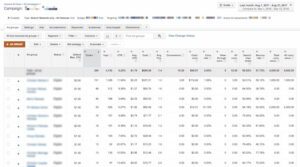If you have worked with a Google Account Strategist on your Google Ads (formerly AdWords) account(s) anytime in the recent past, you were probably strongly encouraged to use all the available ad extensions all of the time for your PPC search campaigns. Using Ad Extensions has the potential to accomplish several things, including to increase the size of your ads when you are in one of the top ad positions, to improve your quality score (the use of ad extensions is part of the quality score calculation), to increase clicks, conversions and impression share. We manage a number of PPC accounts for our clients, and we have certainly seen all of these key metrics be positively impacted by running Ad Extensions.
However, the impact is not universally the same for all campaigns and accounts. Optimization over time (at minimum monthly for newer accounts, and perhaps quarterly for mature accounts) remains a crucial activity. Like many other factors in AdWords, it is important to experiment with the various Ad Extension types that are available, and then to collect, analyze and act on the data resulting from your experiments. Be sure to analyze the performance data for your Ad Extensions and optimize accordingly. I find the standard ad extensions tab views (with customized columns), and segmentation by Click Type and Conversion Name to be especially helpful. Also remember to view performance at both the campaign and account level, as some Extensions may work well in one campaign but not all (the same can be true at the Ad Group level).
 Continuous Improvement & New Ad Extensions
Continuous Improvement & New Ad Extensions
When running or optimizing Ad Extensions, we suggest maintaining a continuous improvement posture. For example, once you have identified good performers, as well as average and mediocre or poor performers, keep the best ones running, pause the low performers, and try a new one for a period of time. Rinse and repeat. Also, be creative with your descriptions – they can certainly influence a searcher to click (or not, if used poorly).
We are beginning to gain traction by using some of the newer Ad Extensions like Price, Message, and Structured Snippets. We find it very helpful to learn the ins and outs of the newer extensions when a Google Strategist is assigned by Google to our account for consultation. Take advantage of these offered consultations – we learn something new every time. They may offer to help you set up a new Ad Extension on the phone or via a screen share session. This can really speed up your learning and help you to avoid common pitfalls.
Mobile Call Extension: A Case Study
The Problem
If your business is anything like many of our customers’ businesses, you may be experiencing an explosion in mobile search volume. We have a couple of accounts where mobile represents 70-80% of the total Google Ads activity. In some of these cases, we have found that the Call Extension is by far the best performing Ad Extension available to us. However, when analyzing our performance data over time, we have sometimes noticed a disturbing trend – as we add more Ad Extensions to an account or campaign, the number of times our Call Extensions show has actually decreased in favor of other Ad Extensions. This is certainly not what you want if your Call Extension is the best performer!
Our first lesson in decreasing Call Extension impressions was a hard one. We had been steadily improving the conversion and CPA performance for one of our larger customers over several months’ period. After a few great months in a row, conversions started trending down. It wasn’t a huge drop, but the cumulative effect over several weeks was very noticeable. We scrambled to evaluate potential issues like the loss of conversion tracking data, broken website links, mistakenly pausing a good keyword(s), etc. After several days of analysis – and frankly, knee-jerk reactions – we realized that one conversion category (listed under Conversion Name or Conversion Category when segmenting data in Google Ads) was down significantly. It was Calls from Ad Extensions. We had been adding and trying new Ad Extensions on the account for the 4-8 weeks prior to our discovery. When we looked at the data comparing the most current time period to progressively older periods, we saw that Call Extension impression volume was progressively dropping over the period when we added new Extensions. Since Calls from Ads were our leading conversion category, our conversion volume fell in line with the Call Extension impression volume. Bummer!
The Solution
To correct this issue, we immediately paused or removed all of the Ad Extensions except Call and Location. As soon as we did this, Call Extension volume and Calls from Ads conversions began to increase again. Phew! But Arrrrgh!#@%?!
After the dust settled, we began searching for potential causes on AdWords Help, AdWords forums, general Google searches, etc. We found nothing that explained the issue to our satisfaction. Since we generally have at least 6 to 8 Google Strategists assigned to various of our customers’ AdWords accounts each quarter, we began to explain our real world findings to them. Most did not have an answer but offered to explore within the Google Ads technical realm. We received responses back to the effect that there was not a clear answer, and that perhaps we should re-introduce more Ad Extensions over time and observe what happens.
The Takeaway
Weeks and then months went by without a good answer. Finally, we worked with a Google Strategist assigned to the account where we learned the hard lesson. Dutifully utilizing his AdWords tools and analytics, the Strategist suggested utilizing more Ad Extensions as an improvement opportunity. I re-told our saga one more time and relayed that we would be eternally grateful if he could help us get to the bottom of this issue. He explained that Google optimizes the various Ad Extensions for us over time. I responded that the optimization did not seem to be working for us when it came to Call Extensions, and he promised to research the issue. Within a couple of hours, I received a callback. He had reviewed in detail the information available to him and spoken to tech reps – and he had a potential answer for us! AdWords optimization relies on receiving lots of data back from searchers’ interactions on our customers’ websites. In the case of Calls from Ad Extensions, the searcher never goes to our customer’s website, and thus the data to optimize on is very limited as compared to other Ad Extensions. BINGO! (i.e. overhead light bulb on; elevator arrived at the top floor; etc.)
In closing the phone call, the Google Strategist delivered another key message and an important reminder. A best practice may not fit every situation, which seems to be the case for this mobile-call-dominated AdWords account. Use your analytics. Review your performance data and act accordingly. If you hit your thumb with a hammer and it hurts – stop doing that! (If you add an Ad Extension and it hurts your account performance, pause it and go with what works.).

